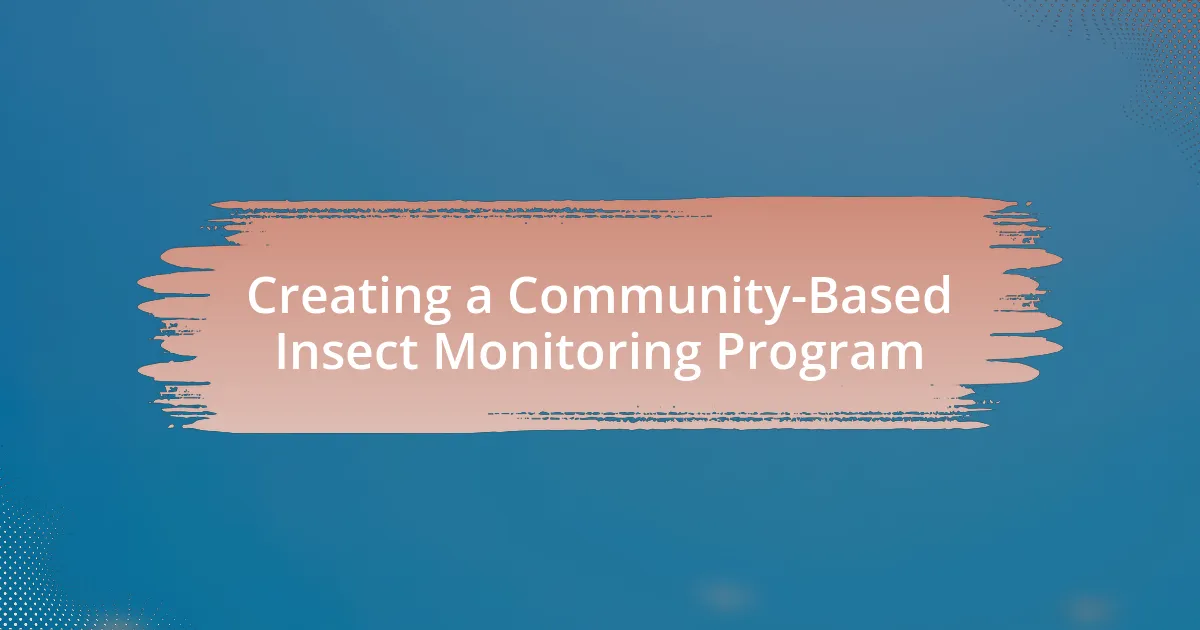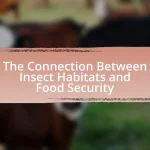A Community-Based Insect Monitoring Program is a collaborative initiative that involves local communities in observing and reporting insect populations and behaviors to gather data on insect diversity, abundance, and distribution. The article outlines the program’s functioning, key components, and the importance of community participation in enhancing data collection and ecological awareness. It discusses the ecological benefits of monitoring insects, the challenges faced in establishing such programs, and strategies for effective implementation, including training, resource allocation, and technology integration. Additionally, it highlights the significance of selecting relevant insect species for monitoring and the best practices for sustaining community engagement and ongoing data collection.
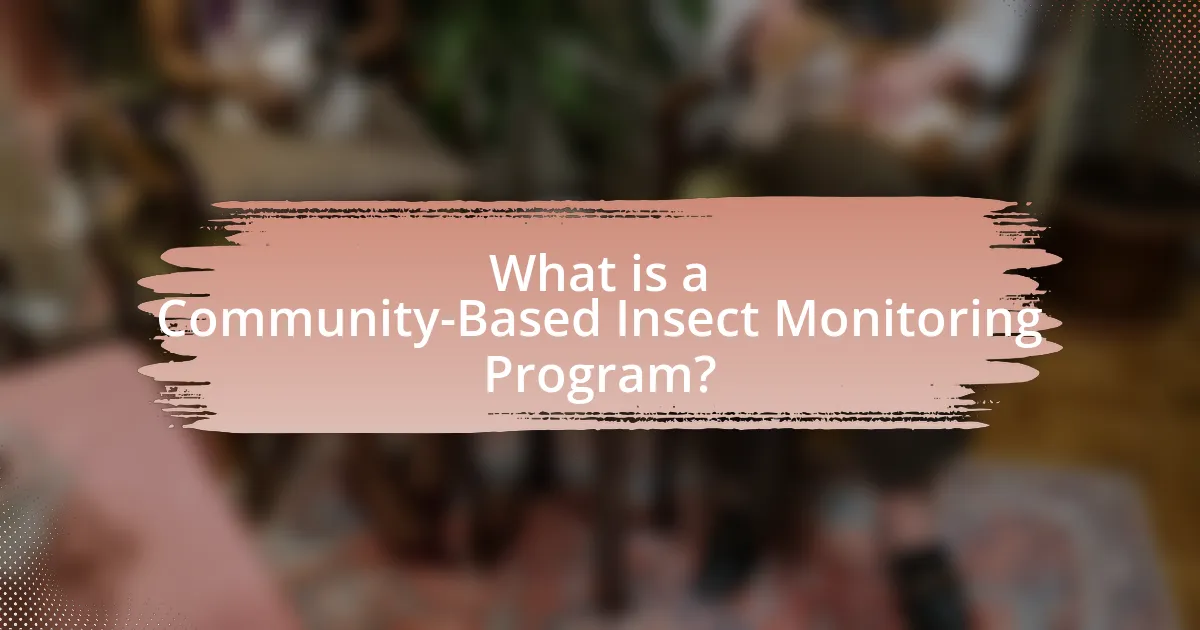
What is a Community-Based Insect Monitoring Program?
A Community-Based Insect Monitoring Program is a collaborative initiative that engages local communities in the systematic observation and reporting of insect populations and behaviors. These programs aim to gather data on insect diversity, abundance, and distribution, which can inform conservation efforts and ecological research. Evidence shows that community involvement enhances data collection efficiency and fosters environmental awareness, as seen in programs like the Great Sunflower Project, which mobilizes volunteers to monitor pollinator populations across North America.
How does a Community-Based Insect Monitoring Program function?
A Community-Based Insect Monitoring Program functions by engaging local residents in the systematic observation and reporting of insect populations and behaviors. Participants are trained to identify specific insect species, collect data, and submit their findings to a centralized database, which allows for the aggregation and analysis of information. This approach fosters community involvement and enhances data collection efforts, as evidenced by studies showing that citizen science initiatives can significantly increase the volume and diversity of ecological data collected. For instance, a study published in the journal “Biological Conservation” highlighted that community involvement in monitoring programs led to a 50% increase in species detection compared to traditional methods.
What are the key components of a Community-Based Insect Monitoring Program?
The key components of a Community-Based Insect Monitoring Program include community engagement, standardized monitoring protocols, data collection and analysis, and feedback mechanisms. Community engagement ensures local participation and ownership, fostering a sense of responsibility among residents. Standardized monitoring protocols provide consistency in data collection, allowing for reliable comparisons over time. Data collection and analysis involve gathering information on insect populations and their impacts, which can inform local decision-making. Feedback mechanisms enable the community to receive updates on findings and adapt strategies based on results, enhancing the program’s effectiveness. These components collectively contribute to a successful and sustainable monitoring initiative.
How do community members participate in the monitoring process?
Community members participate in the monitoring process by actively engaging in data collection, reporting observations, and analyzing findings related to insect populations. This involvement allows them to contribute valuable local knowledge and enhances the accuracy of monitoring efforts. For instance, studies have shown that citizen science initiatives, where community members gather data, can significantly increase the volume of information collected, leading to more comprehensive assessments of biodiversity and ecosystem health.
Why is a Community-Based Insect Monitoring Program important?
A Community-Based Insect Monitoring Program is important because it empowers local communities to actively participate in biodiversity conservation and pest management. This program enhances data collection on insect populations, which is crucial for understanding ecosystem health and detecting changes over time. Research indicates that community involvement leads to more accurate and comprehensive data, as local participants can monitor areas that may be overlooked by professional scientists. For instance, a study published in the journal “Biological Conservation” found that citizen science initiatives significantly increased the volume of data collected on insect diversity, thereby improving conservation strategies.
What ecological benefits does insect monitoring provide?
Insect monitoring provides crucial ecological benefits, including the assessment of biodiversity, early detection of environmental changes, and the evaluation of ecosystem health. By tracking insect populations, researchers can gauge the overall health of ecosystems, as insects are key indicators of environmental conditions. For instance, studies have shown that declines in insect diversity can signal broader ecological issues, such as habitat loss or climate change impacts. Furthermore, monitoring can help identify invasive species, which can disrupt local ecosystems, allowing for timely management interventions. This data-driven approach supports conservation efforts and informs policy decisions aimed at preserving biodiversity and ecosystem integrity.
How does it contribute to community awareness and education?
A community-based insect monitoring program contributes to community awareness and education by actively engaging residents in the observation and reporting of local insect populations. This hands-on involvement fosters a deeper understanding of biodiversity and ecosystem health, as participants learn about the roles insects play in pollination, decomposition, and food webs. Research indicates that citizen science initiatives, such as insect monitoring, can enhance public knowledge and interest in environmental issues, leading to increased stewardship and advocacy for local ecosystems. For example, a study published in the journal “Biological Conservation” found that participants in citizen science projects reported a significant increase in their environmental awareness and knowledge after engaging in monitoring activities.
What challenges might arise in establishing a Community-Based Insect Monitoring Program?
Establishing a Community-Based Insect Monitoring Program may face challenges such as community engagement, data accuracy, and resource allocation. Community engagement is crucial, as lack of interest or participation can hinder the program’s effectiveness; studies show that active community involvement increases data reliability and program sustainability. Data accuracy can be compromised due to varying levels of expertise among volunteers, which may lead to inconsistent monitoring results; research indicates that training and clear guidelines are essential for maintaining data quality. Additionally, resource allocation poses a challenge, as funding and materials may be limited, impacting the program’s ability to operate effectively; according to the National Invasive Species Council, securing adequate resources is vital for the success of monitoring initiatives.
What are common obstacles faced by communities in insect monitoring?
Common obstacles faced by communities in insect monitoring include lack of funding, insufficient training, and limited access to technology. Funding shortages hinder the ability to purchase necessary equipment and resources for effective monitoring. Insufficient training leads to a lack of expertise among community members, which can result in inaccurate data collection and analysis. Limited access to technology, such as software for data management and analysis, restricts the ability to effectively track and report insect populations. These challenges collectively impede the establishment and sustainability of community-based insect monitoring programs.
How can these challenges be effectively addressed?
To effectively address the challenges of creating a community-based insect monitoring program, it is essential to implement structured training and engagement initiatives for community members. Training programs can equip participants with the necessary skills to identify and report insect species accurately, fostering a sense of ownership and responsibility. Research indicates that community involvement in citizen science projects enhances data quality and increases public awareness of biodiversity (Bonney et al., 2014, “Citizen Science: A Developing Tool for Expanding Science Knowledge and Engagement”). Additionally, establishing clear communication channels between scientists and community members can facilitate ongoing support and feedback, ensuring the program adapts to local needs and challenges.
How can communities effectively implement a Community-Based Insect Monitoring Program?
Communities can effectively implement a Community-Based Insect Monitoring Program by establishing clear objectives, engaging local stakeholders, and utilizing standardized monitoring protocols. Clear objectives help define the purpose of the program, such as tracking pest populations or assessing biodiversity. Engaging local stakeholders, including residents, schools, and local organizations, fosters community involvement and ensures diverse perspectives are considered. Utilizing standardized monitoring protocols, such as those developed by the North American Butterfly Association, ensures consistency and reliability in data collection, which is crucial for effective analysis and decision-making. These steps create a structured approach that enhances the program’s effectiveness and sustainability.
What steps should be taken to initiate the program?
To initiate the program, first, establish a clear objective for the community-based insect monitoring program, defining what specific insect populations or behaviors will be monitored. Next, recruit community members and stakeholders to participate, ensuring a diverse group that includes local residents, schools, and environmental organizations. Following recruitment, provide training sessions to educate participants on monitoring techniques, data collection methods, and the importance of insect biodiversity. Finally, develop a structured plan for data collection and analysis, including timelines and reporting mechanisms to share findings with the community. These steps are essential for creating an effective and sustainable monitoring program that engages the community and contributes to local ecological knowledge.
How can technology enhance the monitoring process?
Technology can enhance the monitoring process by providing real-time data collection and analysis through tools such as mobile applications, remote sensing, and data analytics platforms. These technologies enable community members to easily report insect sightings and environmental conditions, facilitating faster response times and more accurate assessments of insect populations. For instance, the use of GPS-enabled devices allows for precise location tracking of insect occurrences, while cloud-based data storage ensures that information is accessible and can be analyzed collaboratively. Studies have shown that integrating technology into monitoring programs increases participation rates and improves data quality, as evidenced by the success of citizen science initiatives that leverage smartphone apps for biodiversity tracking.
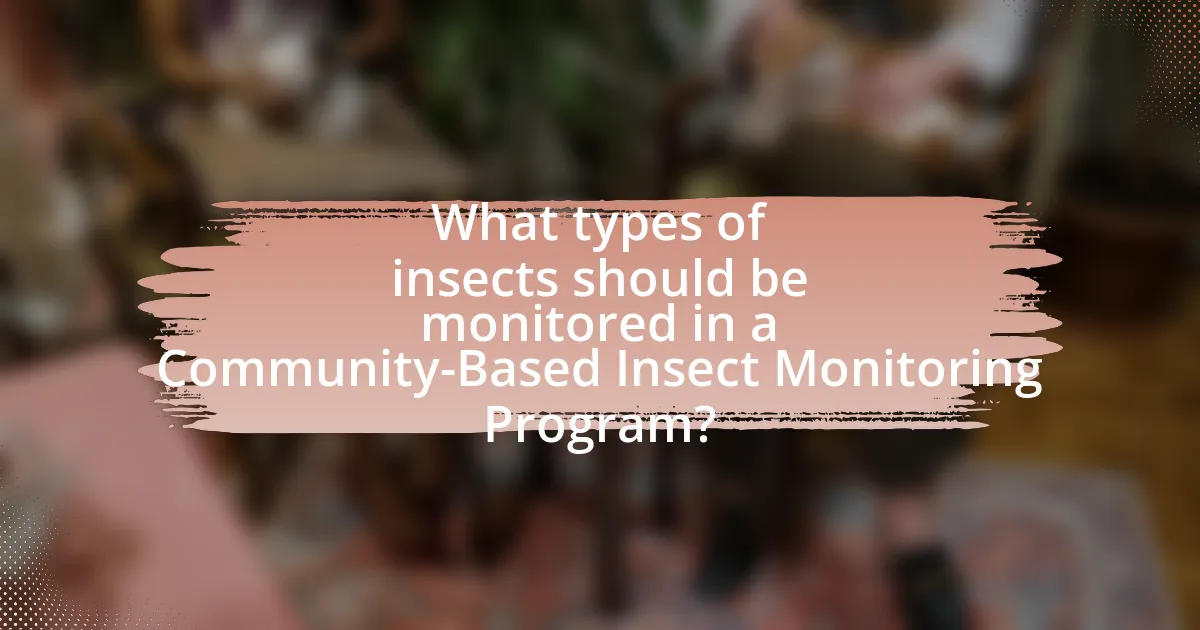
What types of insects should be monitored in a Community-Based Insect Monitoring Program?
In a Community-Based Insect Monitoring Program, it is essential to monitor pollinators, pest species, and indicator insects. Pollinators, such as bees and butterflies, are crucial for ecosystem health and agricultural productivity. Pest species, including aphids and locusts, can significantly impact crops and local biodiversity. Indicator insects, like certain beetles and mayflies, provide insights into environmental changes and ecosystem health. Monitoring these types of insects helps in understanding ecological dynamics and informs conservation efforts.
How do you determine which insect species are most relevant to monitor?
To determine which insect species are most relevant to monitor, researchers assess ecological significance, economic impact, and conservation status. Ecologically significant species often play crucial roles in their ecosystems, such as pollinators or decomposers, making their monitoring vital for ecosystem health. Economically impactful species, like agricultural pests or beneficial insects, directly affect human activities and livelihoods, necessitating their surveillance. Additionally, species with declining populations or those classified as threatened or endangered require monitoring to inform conservation efforts. For example, the decline of pollinators like bees has prompted extensive monitoring due to their essential role in food production and ecosystem stability.
What criteria should be used to select target insect species?
To select target insect species for a community-based insect monitoring program, criteria should include ecological significance, economic impact, and ease of identification. Ecological significance refers to the role the insect plays in its ecosystem, such as pollination or pest control, which can influence biodiversity and ecosystem health. Economic impact involves assessing species that affect agriculture, forestry, or human health, as these can have substantial financial implications. Ease of identification ensures that community members can accurately recognize and report on the species, facilitating effective monitoring. These criteria are supported by studies indicating that focusing on species with clear ecological roles and economic relevance enhances the effectiveness of monitoring efforts and community engagement.
How can local biodiversity influence species selection?
Local biodiversity significantly influences species selection by providing a variety of ecological niches and interactions that determine which species thrive in a given area. High local biodiversity often leads to increased competition and resource availability, which can favor certain species over others based on their adaptability and ecological roles. For example, studies have shown that areas with diverse plant communities support a wider range of insect species, as these insects rely on specific plants for food and habitat. This relationship is evident in research conducted by the National Academy of Sciences, which found that diverse ecosystems enhance species richness and stability, thereby influencing the selection of species that can coexist and flourish within those environments.
What methods are used for insect monitoring in community programs?
Insect monitoring in community programs typically employs methods such as visual surveys, trapping, and citizen science initiatives. Visual surveys involve trained volunteers or community members observing and recording insect populations in designated areas, which allows for real-time data collection. Trapping methods, including pitfall traps and sticky traps, capture insects for identification and population assessment, providing quantitative data on species presence and abundance. Citizen science initiatives engage community members in data collection and reporting, enhancing public awareness and involvement while contributing to larger datasets. These methods have been validated by studies showing their effectiveness in tracking insect diversity and abundance in various ecosystems.
What are the most effective sampling techniques for community monitoring?
The most effective sampling techniques for community monitoring include stratified random sampling, systematic sampling, and participatory sampling. Stratified random sampling ensures that different subgroups within a community are represented, which enhances the accuracy of data collected. Systematic sampling involves selecting samples at regular intervals, providing a structured approach that can reduce bias. Participatory sampling engages community members in the data collection process, fostering local knowledge and increasing the reliability of the information gathered. These techniques have been validated in various studies, such as the research conducted by H. J. B. Birnbaum et al. in “Community-Based Monitoring of Insects: A Practical Guide,” which highlights their effectiveness in capturing diverse ecological data.
How can data collection be standardized across different communities?
Data collection can be standardized across different communities by implementing uniform protocols and guidelines that dictate the methods, tools, and metrics used for data gathering. Establishing a common framework ensures that all participating communities collect data in a consistent manner, which facilitates comparability and analysis. For instance, the use of standardized data sheets, specific identification keys for insects, and training sessions for community members can enhance the reliability of the data collected. Research conducted by the National Ecological Observatory Network (NEON) emphasizes that standardized methodologies lead to improved data quality and comparability across diverse ecological studies.
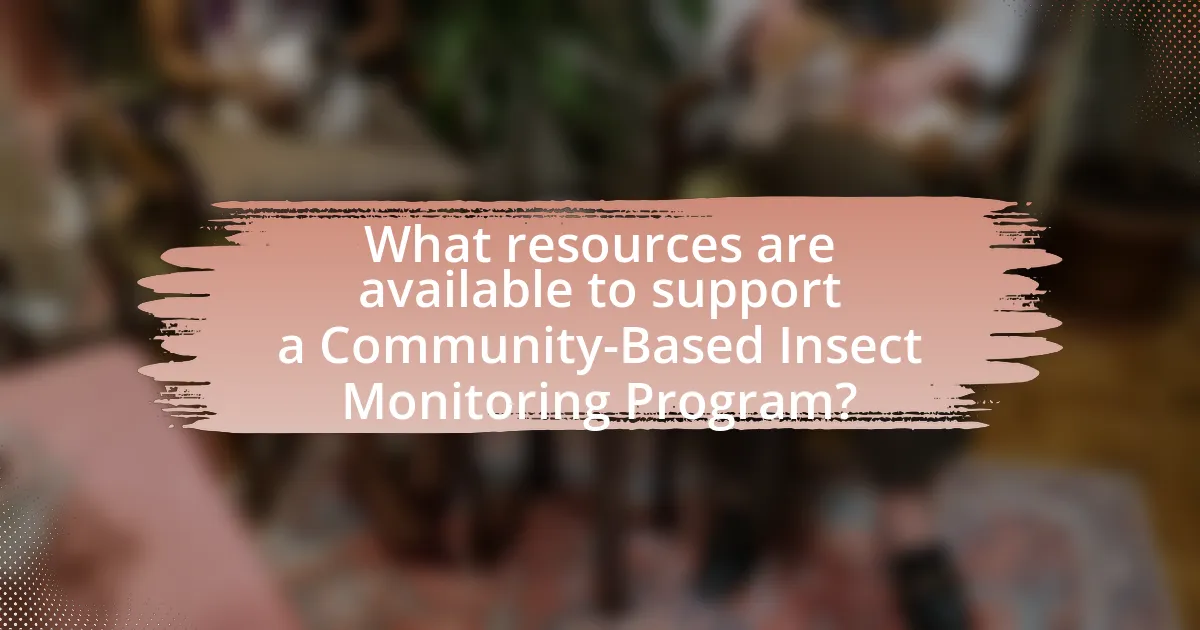
What resources are available to support a Community-Based Insect Monitoring Program?
Resources available to support a Community-Based Insect Monitoring Program include educational materials, funding opportunities, and technological tools. Educational materials, such as guides and training workshops, help community members understand insect identification and monitoring techniques. Funding opportunities can be sourced from local government grants, non-profit organizations, and environmental agencies, which often provide financial support for community initiatives. Technological tools, including mobile apps for data collection and online platforms for sharing findings, enhance the efficiency and effectiveness of monitoring efforts. For instance, the iNaturalist app allows users to document and share insect observations, contributing to larger datasets used for research and conservation.
How can communities access funding for insect monitoring initiatives?
Communities can access funding for insect monitoring initiatives through various sources such as government grants, nonprofit organizations, and crowdfunding platforms. For instance, the U.S. Environmental Protection Agency offers grants specifically for environmental monitoring projects, including insect studies, which can provide substantial financial support. Additionally, organizations like the National Fish and Wildlife Foundation fund community-based conservation projects, including insect monitoring. Crowdfunding platforms like GoFundMe or Kickstarter also allow communities to raise funds directly from individuals interested in supporting local environmental initiatives. These funding avenues enable communities to implement and sustain effective insect monitoring programs.
What grants or sponsorships are available for community programs?
Various grants and sponsorships are available for community programs, including the Community Development Block Grant (CDBG) program, which provides federal funding to local governments for community development projects. Additionally, the National Endowment for the Arts (NEA) offers grants for community-based arts projects, while the Environmental Protection Agency (EPA) provides funding for environmental education initiatives. These funding sources support diverse community programs aimed at enhancing local engagement and addressing specific community needs.
How can partnerships with local organizations enhance resource availability?
Partnerships with local organizations can enhance resource availability by leveraging shared networks, expertise, and community engagement. Local organizations often have established relationships within the community, which can facilitate access to resources such as funding, volunteers, and local knowledge. For instance, a study by the National Institute of Food and Agriculture highlights that collaborations between universities and local nonprofits can lead to increased funding opportunities and resource sharing, ultimately improving program effectiveness. Additionally, local organizations can mobilize community members, providing a larger pool of volunteers and participants for initiatives like insect monitoring, thereby increasing the overall capacity and reach of the program.
What training and educational resources are necessary for participants?
Participants in a community-based insect monitoring program require training in entomology, data collection methods, and species identification. This training ensures that participants can accurately observe and record insect populations, which is critical for effective monitoring. Educational resources such as field guides, online courses, and workshops led by entomologists provide the necessary knowledge and skills. For instance, the “Insect Identification and Monitoring” workshop by the Entomological Society offers hands-on experience and expert guidance, reinforcing the importance of proper training in achieving reliable data collection.
How can workshops and training sessions be structured for community members?
Workshops and training sessions for community members can be structured by incorporating a clear agenda, interactive activities, and practical applications. A well-defined agenda ensures that all relevant topics are covered, such as the importance of insect monitoring, identification techniques, and data collection methods. Interactive activities, such as hands-on demonstrations and group discussions, engage participants and enhance learning retention. Practical applications, like field exercises where community members practice monitoring techniques, solidify their understanding and encourage active participation. Research indicates that structured training sessions with these elements lead to higher engagement and effectiveness in community programs, as seen in the “Community-Based Insect Monitoring Program” case studies, which highlight successful participant outcomes through structured learning approaches.
What materials are essential for effective learning and engagement?
Essential materials for effective learning and engagement in a community-based insect monitoring program include field guides, data collection tools, educational resources, and community engagement materials. Field guides provide essential identification information for various insect species, enabling participants to accurately recognize and record their findings. Data collection tools, such as notebooks, digital apps, or spreadsheets, facilitate systematic recording of observations, which is crucial for monitoring and analysis. Educational resources, including workshops, instructional videos, and online courses, enhance participants’ understanding of insect ecology and monitoring techniques. Community engagement materials, such as flyers, newsletters, and social media content, promote awareness and encourage participation, fostering a collaborative learning environment. These materials collectively support effective learning and engagement by providing the necessary knowledge, tools, and community involvement to successfully monitor insect populations.
What are best practices for sustaining a Community-Based Insect Monitoring Program?
Best practices for sustaining a Community-Based Insect Monitoring Program include establishing clear objectives, engaging community members, providing training, and ensuring ongoing communication. Clear objectives guide the program’s focus and help measure success, while engaging community members fosters ownership and participation. Training equips volunteers with necessary skills for accurate data collection, and ongoing communication keeps participants informed and motivated. Research indicates that programs with strong community involvement and clear goals are more likely to succeed, as evidenced by the success of the Community Collaborative Rain, Hail and Snow Network, which relies on local volunteers for data collection and has shown increased community engagement and data reliability.
How can community engagement be maintained over time?
Community engagement can be maintained over time by fostering continuous communication and providing ongoing opportunities for participation. Regular updates through newsletters, social media, and community meetings keep members informed and involved. Additionally, creating diverse roles within the program allows community members to contribute in ways that align with their interests and skills, enhancing their investment in the initiative. Research indicates that sustained engagement is linked to a sense of ownership and belonging, which can be cultivated through recognition of contributions and celebrating milestones together.
What strategies can be implemented to ensure ongoing data collection and analysis?
To ensure ongoing data collection and analysis in a community-based insect monitoring program, implementing a structured framework that includes regular training sessions, standardized data collection protocols, and the use of technology for real-time data entry is essential. Regular training sessions for community volunteers enhance their skills and understanding of data collection methods, ensuring consistency and accuracy. Standardized protocols provide clear guidelines on how to collect and record data, which minimizes variability and improves the reliability of the data collected. Additionally, utilizing mobile applications or online platforms for real-time data entry allows for immediate analysis and feedback, facilitating timely decision-making and adjustments to the monitoring program. These strategies are supported by studies showing that structured training and technology integration significantly improve data quality and participant engagement in citizen science initiatives.
